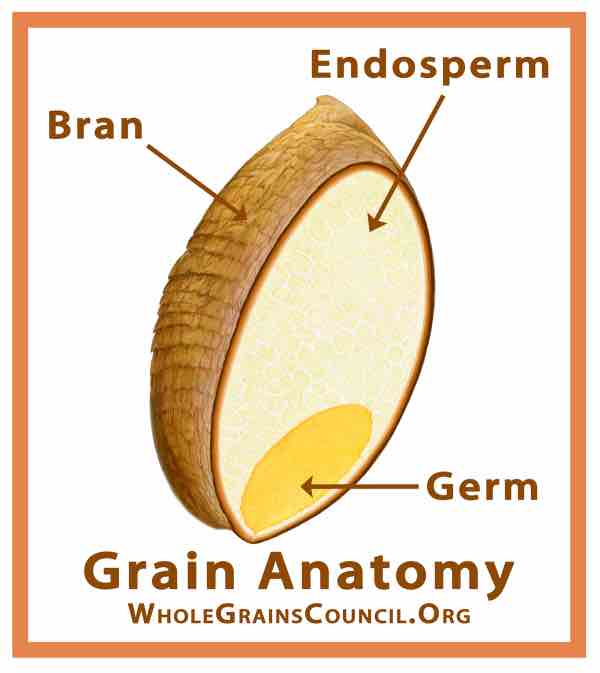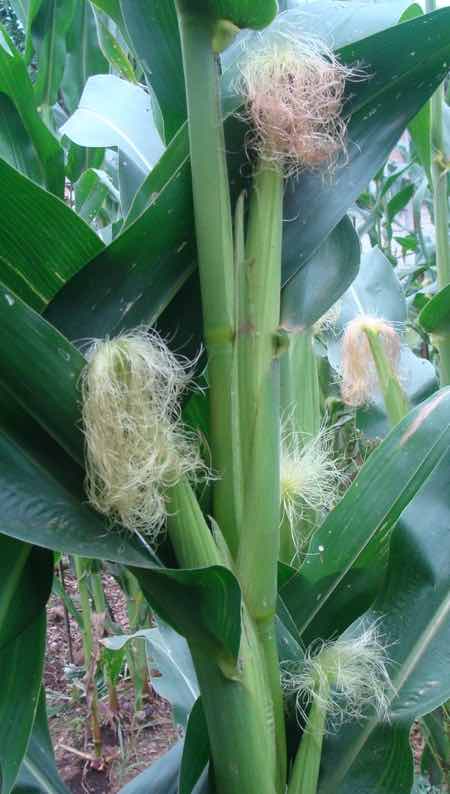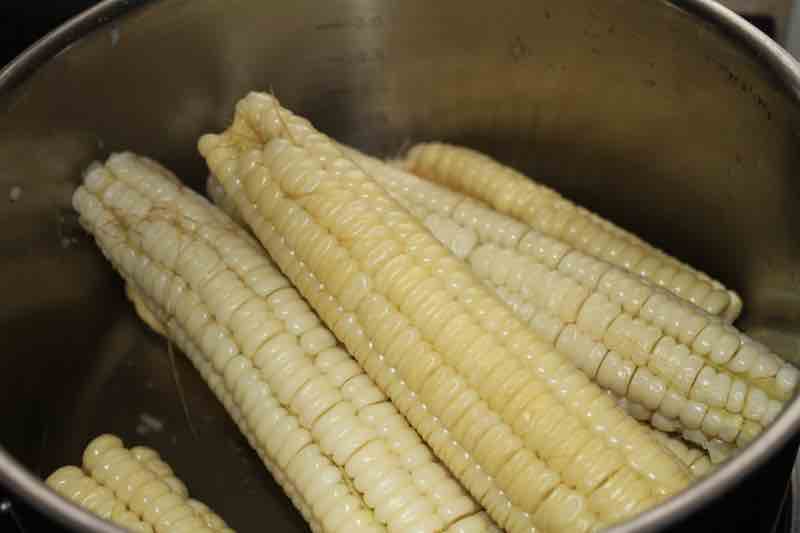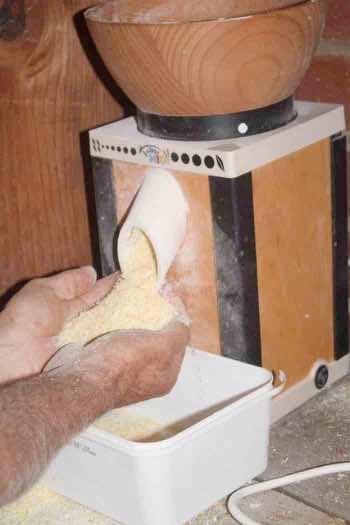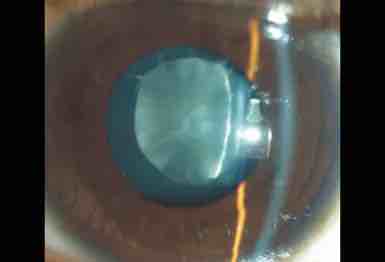| Back to Back Issues Page |
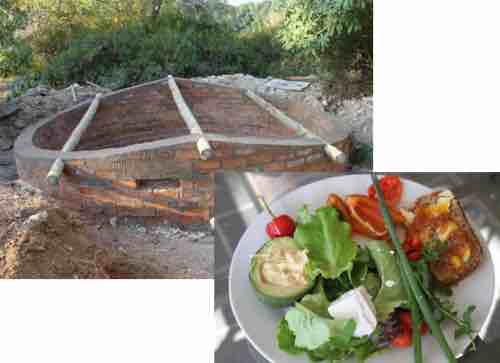 |
|
Refined maize meal and stunting January 22, 2023 |
DearRefined maize meal and stuntingThis column on refined maize meal and stunting challenges us to return to the whole-grain porridge, often called grits; and corn on the cob. Maize, also known as corn, comes from Central America. It is the third most enjoyed grain worldwide after rice and wheat. There are three parts of all grains; the bran, germ and endosperm.
Blindness and breast tumoursThe bran contains the fibre, B-vitamins and some of the protein; and important phytonutrients. The germ has the fat, more amino-acids and other minerals.In particular the germ and bran of maize contain large amounts of lutein and zeaxanthin, two phytonutrients vitally important in the prevention of age-related macular degeneration.[1] The bran contains an important phytonutrient called a lignan; it has a chemical structure very similar to female human oestrogen. Women who enjoy true wholegrains daily have a 50% lower level of malignant breast tumours; that's massive.[2] The lignans compete with human oestrogen at sites on the breast.
"Exposure to plants and green space, and particularly to gardening, is beneficial to mental and physical wellbeing. Health professionals should encourage their patients to make use of green space and to work in gardens." - Clinical Medicine (PMC6334070)
100% whole grains are good sources of several important minerals, notably potassium, magnesium and calcium. Corn on the cob contains a great many minerals, vitamins and phytonutrients; and the protein. Once maize has been refined, removing the bran and germ, most of the important parts are lost. Don't buy into the lame excuse that refined grains have been "enriched." First the millers remove the naturally-occurring minerals and vitamins and then have the audacity to replace them with synthetics; and have us believe that it is better than Mother Nature could have done. There's disturbing research that calcium from industrial sources, in tablet form or added to refined flour to "enrich" it actually raises blood pressure, the prevalence of heart disease and the risk of dementia.
FibreThe "industrial diet" enjoyed by much of the world contains less than half the recommended amount of fibre. Consequently diseases of the gastrointestinal tract are rife. Constipation affects 20% of Americans; the figures for the rest of the world are no doubt comparable.Refining of maize meal and other grains is a major contributor to malignant tumours of the bowel.
MicrobiomeThe friendly bugs in the colon known collectively as the microbiome are completely dependent on fibre for nourishment; they have a major role to play in the health of the lining of the gut, generalised inflammation in the body and many diseases.The value of probiotics is greatly impaired without dietary fibre.
TasteRefined maizemeal has almost no taste; extraction of the germ and bran removes those phytochemicals that make old-fashioned grits a favourite in many places. Consequently large amounts of salt and sugar have to be added.
Blood sugarRefined maize meal is highly glycemic, raising blood glucose and is a major contributor to both obesity and diabetes.20 years after the McGovern committee recommended Americans eat more starch and less fat, the prevalence of diabetes began to soar, and continues to do so to this day; largely because whole grains are so hard to find. The world over people have become accustomed to the texture of highly-refined grains; their lips and tongues have learned to dislike chewing and fibrous food in general. 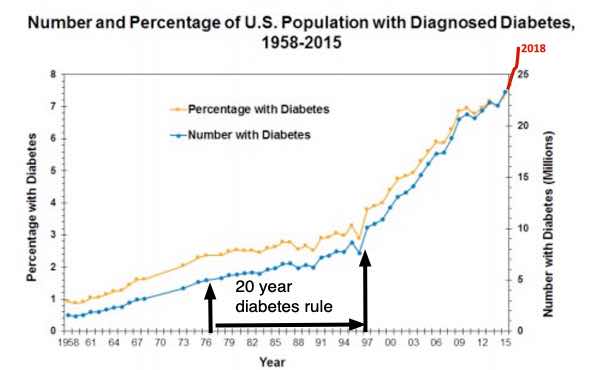
Twenty-year-diabetes-rule.html Refined maize meal and stuntingResearch shows that about a half of the children in rural villages in South Africa are permanently stunted, mentally or physically, or both. Nationally it affects over a quarter of our kids. No amount of good nutrition later in life can undo the damage done in the formative years.The extraction of much of the protein from maize meal by millers is a large part of the problem. Undoubtedly there are other factors; children deficient in folate for example cannot perform well in school. 1 cup of unrefined corn, slightly more than an ear, contains nearly one fifth of the recommended daily allowance of folate. ProteinThere is much research showing that young and old need more protein, but rather less in the middle years.With children in Africa so dependent on the protein from maize, removal of many of the amino-acids from their staple diet is a huge contributor to stunting and illness. Maize does not contain a "complete protein;" it is deficient in certain amino acids, notably lysine and tryptophan. Just half a cup of milk a day would sort that problem out. Legumes like beans and peas make a great mix with corn. Succotash was a staple in America for this very reason. When did you last prepare it? Children like all of us should also be enjoying nuts and seeds on a daily basis; they are also good sources of protein.
Blindness in children1.4 million children throughout the world go blind each year; there are many causes from a vitamin A deficiency to a cataract. 60% die within twelve months of losing their sight.90 million children globally have some form of sight loss. There is a rapidly growing epidemic of myopia. It has massive financial consequences; one third of the total economic cost of blindness in all age groups is in children. Childhood cataracts occur mainly in Africa and Asia. They are associated with low birth weight; below 2.5kg. The chief cause is maternal malnutrition; in particular protein deficiency. There is reduced glutathione in the cord blood. Glutathione is a protein synthesised in the liver from three amino acids; glycine, cysteine and glutamic acid. It is a powerful antioxidant too. Interestingly all three are found in relatively large amounts in maize that has not been refined. However the most common milling process extracts nearly half the protein. It's a wickedness beyond comprehension. Human greed is the driving force; the hominy chop in corn is where the value lies. Our children are fed on what remains.
Another cause of damage to the lens in children is a deficiency of B6; pyridoxine. This results in a serious rise in a toxic chemical in the blood called homocysteine. It is a normal breakdown product of protein metabolism but its immediate degradation is dependent on a diet rich in B vitamins and certain minerals. Homocysteinemia is strongly linked to many other serious degenerative conditions in adults too; Alzheimer's disease for example. Unrefined maize meal and corn on the cob are good sources of pyridoxine; one portion contains more than 10% of the Daily Value. Chickpeas are the richest source by the way. Blindness in adultsBlindness in adults is most commonly caused by Senile Nuclear Cataracts and Age-related Macular Degeneration. Two phytonutrients, lutein and zeaxanthin are found exclusively in the eye to reduce oxidative stress and absorbe damaging blue light. Both are found in abundance in unrefined yellow corn. Dark-green leafy vegetables are a good source too.Diabetes and long-term use of corticosteroids are other frequent causes of blindness. There is also disturbing research that calcium supplements, and most likely when used to "enrich" grains too, contribute to blindness. For elderly folk who are sedentary the mineral isn't absorbed into bone remodeling but is laid down in the coronary arteries and the eyes.
RetrogradationThere's no question about it, grains do raise blood glucose. That is an entirely natural process managed by two hormones from the pancreas.But in "insulin-resistant" folk, read half the population eating the typical industrial diet, this process goes haywire. The result is obesity, type-2 diabetes and all the ensuing chronic degenerative diseases. There is something you can do; allow your starches to cool, be they whole or not, preferably overnight in the fridge and then reheat them. The carb molecules "retrograde" forming what is known as resistant starch; hydrogen-bonds between the chains slow the action of amylase, the enzyme that digests them forming glucose. Grits, bread and a potato salad made on Saturday evening, but enjoyed on Sunday are all less fattening, and less likely to provoke a surge in blood glucose. If you are diabetic, test yourself and see. The fibre, protein and fat in whole grains also slow gastric emptying into the small intestine where the glucose is formed and absorbed.
SpiritualWhatever your religion there is something deeply spiritual about all this. Understanding that our bodies are the temples of Almighty God means that we have a responsibility to care for them.Not just because it means less pain and a greater-likelihood of a life untroubled by the chronic degenerative diseases; but also since we are challenged to holiness, sometimes written as "wholeness." In the Greek the words have the same root. GreedGreed is one of the so-called "deadly sins." Nowhere is it more clearly seen than in the action of food companies that remove the goodness from our meal, enabling them to profit unduly by selling it on to third parties.Millers are just one example, removing much or all of the protein, minerals and many phytonutrients that our bodies desperately need. The big fat lie of false labeling is the hallmark of this great evil; still being legally entitled to call it a "whole grain" even though they have extracted much of the goodness. The rich and educated do have the power to circumnavigate this evil. They can source true 100% whole grains, though so often they too have been seduced by the industrial diet. But for the poor and uneducated who have no understanding of this heinous crime against humanity it is just one more way in which we oppress the "fatherless and widows;" they have no choice but to eat the refined maize meal on the supermarket shelves. Stunting, obesity and diabetes lie just around the corner. Worse large companies have exported this technology to poor countries enabling an elite to become rich; whilst oppressing the poor into the stunting and disease associated with food from which the goodness has been extracted.
CostThe cost of whole corn is minimal; around USD300 per metric ton currently despite the war in Eastern Europe.That is about 30c per kilogramme. Yet the price of Cornflakes for example is around $10/ kg. The packaging costs the company more than the grain.
HoodwinkedIt is a great tragedy that even religious people have become ensnared by the "pattern of this world" when it comes to food. They either have little understanding, or if they do, do not care; and pay the terrible price of loss of wellbeing, pain and a shortening of their lives."Do not conform any longer to the pattern of this world, but be transformed by the renewing of your mind." - Romans 12.2 Is it perhaps time to return to food that the Good Lord gave to us? He declared that it was "very good." And by the renewing of our minds to fully comprehend the great evil that declares that the food that He gave us is at best second-rate, and needs to be refined, preserved and modified; and reared in a cage, barn or feedlot.
"Let the earth bring forth living creatures, cattle and every plant yielding seed and fruit. And God saw everything that he had made, and behold, it was very good." - Genesis 1 BurnoutDoctors not surprisingly have been particular hard hit by the pandemic. Prior to the C-19 virus 81% of physicians in the USA were at least "somewhat" happy outside of work; but by February, 2022 that figure had dropped to 59 percent.Also not unexpectedly those involved in Emergency Medicine took the brunt of the stress; 60% felt burned out. More difficult to interpret is that of those in Preventative Medicine only 26% feel burned out; perhaps it is just because they practise what they preach, taking holidays, getting exercise and eating more healthily.
A few thoughtsAll is not well in the state of Denmark. Millers remove all the best parts from maize, process the refined, nutritionless grain into tasteless breakfast cereals to which large amounts of salt and sugar are then added.Some synthetic minerals and vitamins are added to the cereals, and they have the audacity to call it enriched. Consumers appear to regret their lack of desire for a better lifestyle and nutritious food but in the final analysis they appear unwilling to do anything about it. They wouldn't want to be health-nuts unless they could also have cornflakes every morning for breakfast and doughnuts at the weekend; and these advisories from Bernard Preston were all optional!
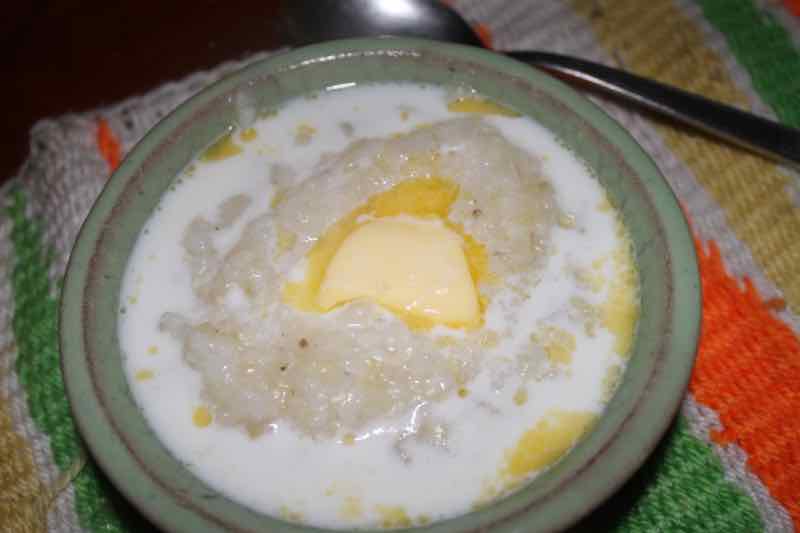
100% wholegrain grits, from yellow or white mealies, is incredibly tasty and full of the nutrients; settle for nothing less. Natural honey and a little cream or butter adds to the flavour and slows the absorption of the glucose.
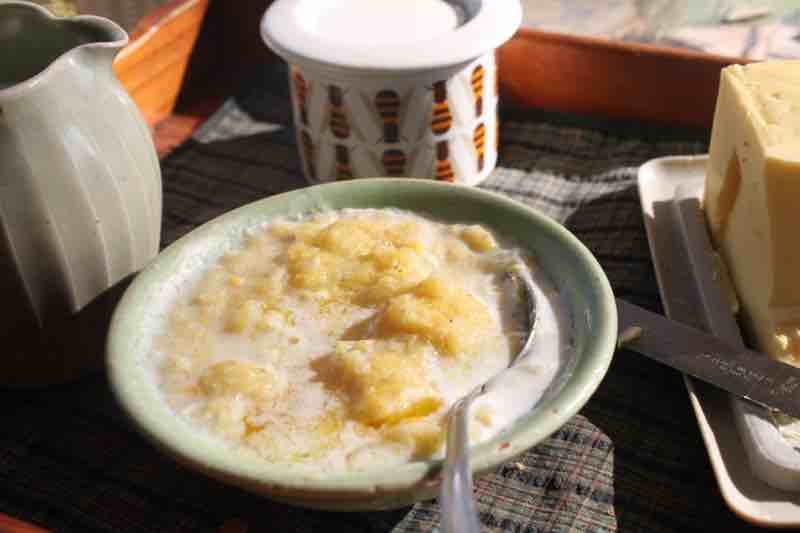
Added protein in this cheesy grits with berries is the food of kings and queens. Dine without guilt if you have found a source of 100% wholegrain. 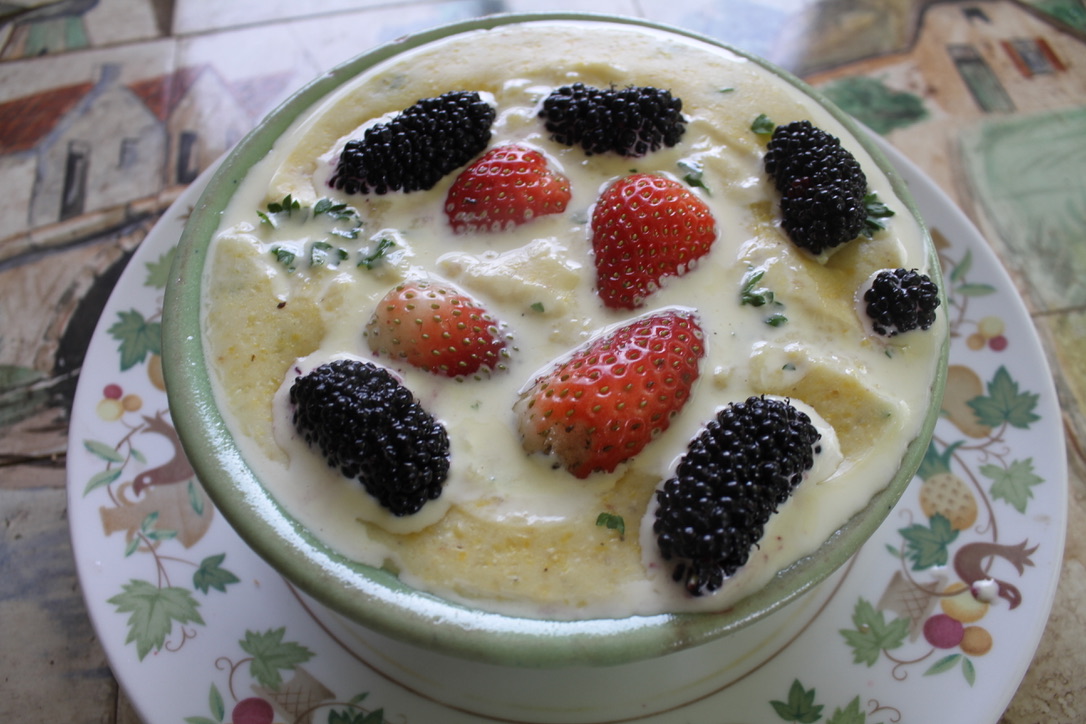
Stone-ground-grits.html To sum upFinding true unrefined maize meal to prevent stunting will probably be difficult. Purchasing your own mill is worth a thought.As I said last month perhaps get together with other like-minded folk who are serious about their wellbeing; one person buys the mill and you share in the spoils. Work out how much you spend on breakfast cereals and supplements; you would be surprised how quickly you will pay it off. In any case unrefined maize meal just tastes so good; you'll never go back to cornflakes. Do let it retrograde overnight; your potato salad too.
Next monthNext month we will look at how you could reduce your electricity bill.Take care of yourself; look after the planet. Plan to live to a strong and zestful ninety, and who knows perhaps even one hundred. Till next month, Bernie
Create a cyan zone at your homeClick here to return to the home page and subscribe to this newsletter, if you have not already. Care for the world, look after your family.It is simple to unsubscribe if you later find it boring or irrelevant. Don't spam, but please forward to a few selected friends who you think might be interested in sitting under the trees they once planted, sipping tea and watching the great-grandchildren growing up; and still able to take long walks.
x Bake your own sourdough bread x Alternative types of water storage x Wear your clothes out x Comfort foods x Create a bee-friendly environment x Go to bed slightly hungry x Keep bees x Blue zone folk are religious x Reduce plastic waste x Family is important x What can go in compost? x Grow broad beans for longevity x Harvest and store sunshine x Blue zone exercise x Harvest and store your rainwater x Create a cyan zone at your home |
| Back to Back Issues Page |
